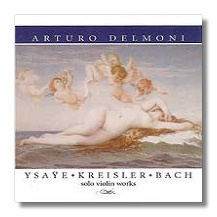
The Internet's Premier Classical Music Source
Related Links
- Latest Reviews
- More Reviews
-
By Composer
-
Collections
DVD & Blu-ray
Books
Concert Reviews
Articles/Interviews
Software
Audio
Search Amazon
Recommended Links
Site News
 CD Review
CD Review
Ysaÿe, Kreisler, Bach

Solo Violin Works
- Eugène Ysaÿe: Sonata for Solo Violin, Op. 27, #2 "Obsession"
- Fritz Kreisler: Recitativo and Scherzo, Op. 6
- Johann Sebastian Bach: Partita #2 in D minor, BWV 1004
Arturo Delmoni, violin
Recorded in December of 1988 in Santa Barbara, California, by Kavichandran Alexander for Water Lily Acoustics
John Marks Records JMR14 1996 ADD 48:28
No one who has heard Joseph Szigeti prise apart the contrapuntal lines of a Bach solo sonata or partita will be likely to brand the instrument as suited only for lyrical monophony. What the violin lacks in brute polyphonic capability (compared to the organ and piano) it makes up in variability of tone color, and no one has ever taken better advantage of the instrument's spectrum than Szigeti.
The works for solo violin on this Arturo Delmoni disc are not cast in Bach's polyphonic pattern. Eugène Ysaÿe's second sonata for solo violin was dedicated to Jacques Thibaud (all six of the sonatas were dedicated to violinists Ysaÿe admired – the very first, in fact, to Szigeti himself). Its fire-and-brimstone emanate as much from Ysaÿe's grand rhetorical gestures in a eeirly chromatic gelatine medium as from the use of the Gregorian Dies irae melody. The notes by Denis Stevens describe Ysaÿe as the greatest lyrical player of his time. Arturo Delmoni seems to have adopted this point of view as well, for his reading, slower than most, sings where others (notably Ruggiero Ricci and Frank Peter Zimmerman) slash and burn. But there's no lack of sulphur in the last movement ("The Furies"), which, for its more deliberate tempo, delivers all the greater a whallop (even Aaron Rosand, who tampered with the ending of this movement in an obvious attempt to screw up the excitement, didn't generate Delmoni's voltage).
Fritz Kreisler's Recitativo and Scherzo Caprice is instantly recognizable as one of the master's own. More virtuosic than many of his shorter encore pieces, it was a return compliment to Ysaÿe, who had dedicated the fourth of his solo sonatas to Kreisler. Delmoni once again takes his time, notably in the opening movement, but he is brilliant in the scherzo. Kreisler never recorded this showpiece, but it's unlikely he would have sounded anything like Delmoni, who, like most violinists who have succeeded in this work, don't try to imitate Kreisler's mannerisms.
Bach's solo sonatas and partitas are a touchstone of the violinist's maturity, and the second partita in particular presents a monumental challenge, both technically and musically. Arturo Delmoni possesses the technical and emotional resources to meet this challenge at least half way. The purity of his sound on his 1780 Guadagnini, with its slight trace of acid, together with the accuracy of his intonation and the general elevation of his style, recall the model performances of these sonatas by Arthur Grumiaux, which are protypes of classical elegance. Only in the chaconne does the smooth power of Delmoni's tone exhibit any strain. And, truth to tell, he lacks the sense of architecture that Milstein was able to create in this work (more conspicuously in the live performances that have recently become available than in either of his sets recorded in the studio).
Tape hiss is noticeable in this orginally analog 1982 recording, which was miked very close to the performer. But only in the chaccone, once again, does that closeness betray any roughness in Delmoni's tone.
This solo recital should be of interest to collectors of violin recordings primarily for its outstanding swashbuckling performance of Ysaÿe's second sonata. This is a work that Milstein claims to have admired, but even if that violinist of violinists had recorded it himself, he couldn't have imparted to it either a nobler grandeur or a more chilling sense of the lower regions. Enthusiastically recommended.
Copyright © 1998, Robert Maxham


















